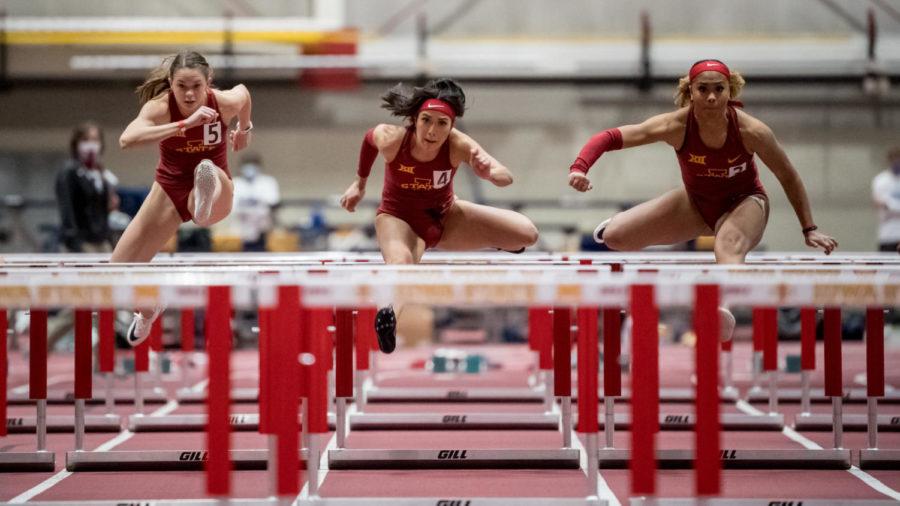Title IX: Track and field and a program’s long history
Kaylyn Hall (left), Katarina Vlahovic (middle) and Tatiana Aholou (right) compete in the women’s 60-meter hurdles at the Cyclone Invite on Jan. 23, 2021.
July 10, 2022
In 1972, Title IX gave women across the nation the promise of equal support in athletics.
At Iowa State, the historic legislation empowered generations of female athletes in the sport of track and field.
Fifty years and one day after the historic legislation, Cyclone track and field athlete Emily March competed in the women’s discus final at the USATF Outdoor Championships in Eugene, Oregon.
But March, who earned First Team All-American honors in 2022, isn’t the only Cyclone bidding to represent her country.
The next day, about 400 miles north and just over the border, Kaylyn Hall and Katarina Vlahovic raced in the 100-meter hurdles semifinals at the Canadian Track and Field Championships.
March received 12th place at the Outdoor Championships in Eugene. Hall would win her heat and advance to place second in the final. Hall’s college teammate Vlahovic placed fourth alongside her in the semifinal heat.
All three represented Iowa State and their home countries successfully, but competing days after the anniversary of Title IX serves as a reminder of the program’s long journey.
Program History
At Iowa State, men’s track and field would begin in 1921.
The first women’s team in 1973 began over fifty years after the university’s male counterparts, but the team found success quickly. Iowa State women’s track and field took home 13 individual national titles in the first decade of competition.
Debbie Esser, competing in the 400-meter hurdles, became the first woman to win the same event four times. She did so, competing in the Association for Intercollegiate Athletics for Women, the female counterpart of the NCAA. She won the 400-meter hurdles every years from 1976-79.
Peg Neppel-Darrah won both the two-mile and three-mile run in 1976, and Debbie Vetter added a national title for the young Cyclone program by winning the 1500-meter run in 1978.
Colleen Hanna and Nawal El Moutawakel added to the Cyclones’ first decade of success with individual national championships in 1982, and in 1984 El Moutawakel became Iowa State’s first female NCAA individual champion.
El Moutawakel later represented Morocco in the 1984 Olympic games and won the gold medal for her home country.
Iowa State added four individual championships in 1981 in the indoor competition in the first ten years as an organized program.
Impact of Title IX
As the impacts of Title IX swept across the country, women’s athletics continued to change. In 1982, the NCAA began championships for women’s sports, effectively ending the AIAW.
Iowa State’s women’s track and field success slowed from its initial decade. In 1990, Iowa State added Lied Recreation Center to its campus.
The $13 million facility housed an indoor track and field facility, and as guaranteed by Title IX, track and field athletes still enjoy equity of the school’s men’s and women’s teams.
In the modern era, the Iowa State women brought its total individual champions up to 24. Compared to its male counterparts, Iowa State women’s track and field has more individual champions despite competing in about half as many seasons.

















